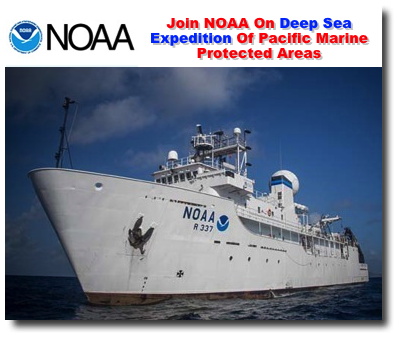Kaimuki, Hawaii
News Item- Powered by MBC NewsMaker
Public Invited To Join NOAA On Deep Sea Expedition Of Pacific Marine Protected Areas
- Tweet

Public invited to join NOAA on deep sea expedition of Pacific marine protected areas
From Aug. 1 to Sept. 29, public can explore deep sea habitats and marine life with scientists and researchers
Contact
Sarah Graddy, sarah.graddy@noaa.gov, 240-479-8378
NOAA Ship Okeanos Explorer will begin two months of dives using unmanned remotely operated vehicles, or ROVs, to explore marine protected areas in the central Pacific Ocean. Starting on Aug. 1, anyone with an internet connection can virtually explore the deep sea with scientists and researchers from their computer or mobile device.
The ship and its crew will investigate deeper waters in and around Papahānaumokuākea Marine National Monument in the Northwestern Hawaiian Islands, Johnston Atoll in the Pacific Remote Islands Marine National Monument, and the Hawaiian Islands Humpback Whale National Marine Sanctuary.
"These areas represent some of the last relatively pristine marine ecosystems on the planet." said Holly Bamford, assistant NOAA administrator for the National Ocean Service performing the duties of the assistant secretary of commerce for conservation and management. "NOAA explores these regions because the data and information we gather helps scientists and resource managers better understand and protect these biological, geological and cultural resources that we are already aware of and those we will discover in the future."
NOAA Ship Okeanos Explorer systematically explores the deep oceans of the world. (Credit: NOAA)
The expedition team will explore the seafloor at depths of 1,300 to 16,250 feet (400 to 5,000 meters) with two ROVs, which are tethered to Okeanos Explorer. The vehicles are outfitted with multiple high-definition cameras to capture imagery which the ship will transmit back to shore. Scientists will participate virtually, guiding the expedition from shore, while the public can tune in and view the exploration in real time at oceanexplorer.noaa.gov.
The work around Johnston Atoll will be the largest scientific effort conducted there since President Obama expanded the Pacific Remote Islands Marine National Monument in September 2014.
"These places provide invaluable habitat for corals, birds and many other species -- that's one of the reasons they've been protected -- but we don't know much about what's in the deep-sea areas," said Samantha Brooke, manager for NOAA's Marine National Monument Program in the NOAA Fisheries.
Expedition leaders anticipate finding large deep-sea coral communities known as coral gardens -- some with coral colonies thought to be thousands of years old -- as well as sponge communities. Both coral gardens and sponge communities provide habitat for a number of other species.
"Given the unexplored nature of these areas, their remoteness and their known status as biodiversity hotspots, I'd be very surprised if we didn't see many animals and phenomena that are new to science," said expedition science team lead Christopher Kelley, associate professor of biology and program biologist at the Hawaii Undersea Research Laboratory, University of Hawaii at Manoa.
Okeanos Explorer just completed two weeks of mapping more than 10,300 square miles (26,700 square kilometers) of seafloor around Johnston Atoll, which is part of the Pacific Remote Islands Marine National Monument.
"Papahānaumokuākea and the sanctuary are home to numerous protected species, undiscovered shipwrecks and sacred maritime landscapes," said Allen Tom, Pacific Islands regional director of NOAA's Office of National Marine Sanctuaries. "With live streaming video, we will be providing an exciting way for people to ‘visit' these special places."
The Pacific Remote Islands and Papahānaumokuākea marine national monuments were established by Presidential proclamations to protect abundant populations of coral, fish, marine mammals and seabirds. Papahānaumokuākea was also established to protect Native Hawaiian heritage and cultural resources. The Hawaiian Islands Humpback Whale National Marine Sanctuary was created by Congress to protect humpback whales and their habitat in Hawaii.
This is the first expedition of a major three-year effort to systematically collect information to support science and management needs within and around the U.S. marine national monuments and NOAA's national marine sanctuaries in the Pacific.
Questions? Ready for an appointment?
- RELATED LINKS
 Kaimuki Hawaii.Com Home Page
Kaimuki Hawaii.Com Home Page
View our featured events, news, businesses and primary links on our home page. Featured Sponsors
Featured Sponsors
Great offers from our sponsors who support the Kaimuki Honolulu, Hawaii community. More...
Kaimuki Hawaii Directory
View Kaimuki, Hawaii primary directories. businesses, non profits, public, government and jobs. Calendar
Calendar
Check out things to do in Kaimuki on the calendar of events. News and Newsletters
News and Newsletters
Keep up with the latest news and happenings in your Kaimuki community. Kaimuki Hawaii Featured Pages
Kaimuki Hawaii Featured Pages
View our directory of feature pages showcasing all the great things Kaimuki, Honolulu, Hawaii has to offer. Go Green in Kaimuki, restaurants, shopping, WiFi Hot Spots, fitness, health, real estate, home and garden, 80+ more directories... More...
Terms of Use / Legal Disclaimer / Privacy Statement
Site Designed and Managed by MacBusiness Consulting
